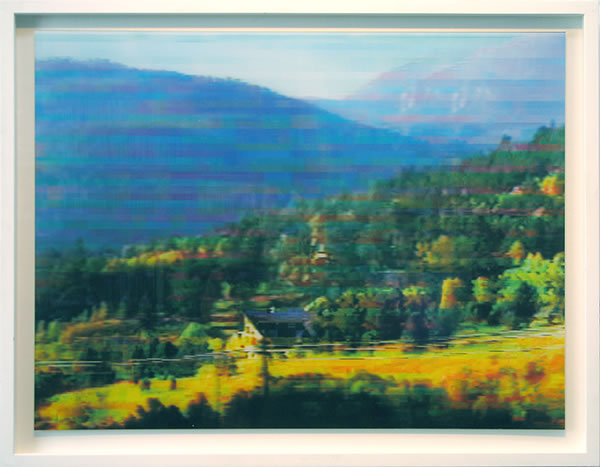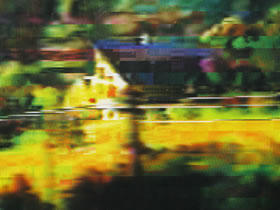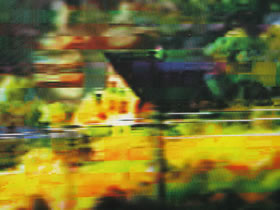
Colorado Impression
2001, Digital cibachrome print, perspex lenticular, 45 x 60cm
edition of 50
Colorado Impression
Eyestorm commissioned my second adventure in lenticular design in 2001, a reinterpretation of a low-resolution landscape photograph from the website of the other Dan Hays. Experiments within painting directly fed into the construction of the piece. The image was divided into six zones, corresponding to the receding space of the pictured scene. Creating the 3D effect involved a process of cutting out these areas in Photoshop and producing a sequence of twelve successive viewpoints by shifting these six zones left or right in relation to each other in regular intervals. Invention of missing information around each cut out zone was needed as they moved over each other. I was keen that the foreground of the scene appeared elevated in front of the picture plane, hence the shifting of this zone in the opposite direction to the rest. The illusion of the image projecting out of the image-object is perhaps the most seductive effect that lenticular stereography offers. It accentuates the quasi-object nature of the image, and presents a visual conundrum in trying to gauge the location of the lenticular sheet in space. Animation was also introduced by digitally modulating the colours of the scene in horizontal strips, presenting a shimmering appearance, the intention being to accentuate the sense of atmospherics, a feeling that the illusion is about to collapse or dissolve, reminiscent of poor quality video.
The big discovery through this project was that there are limitations in the ability to represent deep space presented by landscape imagery. The finished work, Colorado Impression, has a sense of receding stage-flats, becoming fuzzier the further away they are in the illusion, offering atmospheric perspective or a shallow depth of field. From a standard viewing distance, say a meter, the last mountain only appears to be about six inches beneath the picture plane. This would suggest that for successful, life-like representation the genre of still life would be most appropriate for realistic lenticular reproductions. However, it is exactly this conundrum, the minds ability to project deep space into landscape representations, which intrigues me. We do this with regular paintings and photographs. The crude and impoverished depiction of deep space within lenticular prints speaks of the need to cherish, re-live and animate memories of place. Museum dioramas offer a similar effect, not to mention snow-domes.


The original image was rendered into 3D through 24 frames by myself in Photoshop with the advice of Graham Tunnadine of 3D4D.com who produced the finished work.
Eyestorm.com sell the work through their website. Dan Hays in Colorado receives half the royalties. [Or that was the idea. We only ever received royalties for the sale of three out of the edition of fifty in 2001]